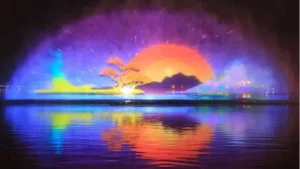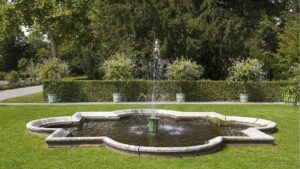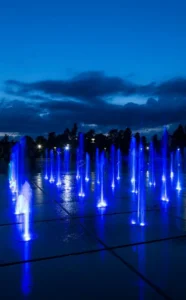- Product Knowledge
The Science and Art of Fountain Water Shapes
Fountains have long been symbols of beauty and tranquility, captivating audiences with their intricate designs and mesmerizing water displays. Understanding the different shapes that water can take in fountain displays is crucial for appreciating the artistry and engineering behind these installations. This article explores the various water shapes in fountains, from simple jets to dynamic sculptures.
The Science Behind Fountain Water Shapes
Basic Principles of Fluid Dynamics
Fluid dynamics is the study of how liquids move and interact with their environment. In fountains, fluid dynamics plays a crucial role in shaping water into various forms. The movement of water is influenced by factors such as pressure, velocity, and the design of the nozzles and pumps.
The Role of Pumps and Nozzles in Shaping Water
Pumps and nozzles are the heart of any fountain, determining the flow rate and direction of the water. High-pressure pumps push water through specially designed nozzles, which shape the water into specific patterns. The size, shape, and arrangement of these nozzles can create a wide range of water effects.
Vertical Jets
Definition and Characteristics
Vertical jets are one of the simplest and most common water shapes in fountains. They consist of water streams that shoot straight up into the air, creating a striking visual effect. The height and thickness of the jets can vary depending on the pressure of the water and the design of the nozzle.
Examples of Simple Vertical Jet Fountains
Vertical jet fountains are found in many public spaces, from city squares to shopping malls. A famous example is the Jet d’Eau in Geneva, Switzerland, which shoots water 140 meters into the air, creating a landmark visible from across the city.
Common Uses in Public and Private Spaces
Vertical jets are popular in both public and private settings due to their simplicity and elegance. They can serve as focal points in gardens, courtyards, and parks, providing a sense of movement and energy.
Dome and Hemispherical Patterns
Definition and Characteristics
Dome and hemispherical water patterns form rounded shapes, resembling a dome or hemisphere. These patterns are created by nozzles that disperse water evenly in all directions, creating a smooth, curved surface.
How Dome-Shaped Water Patterns Are Created
To create a dome-shaped water pattern, water is pushed through a specially designed nozzle that disperses it in a circular motion. The force and angle at which the water is expelled determine the size and shape of the dome.
Visual Impact and Popular Installations
Dome and hemispherical patterns are visually striking and add a touch of elegance to any fountain design. They are often used in decorative fountains in public squares, shopping centers, and private gardens. An example of a popular installation is the Buckingham Fountain in Chicago, which features multiple dome-shaped water displays.
Cascading Sheets
Definition and Characteristics
Cascading sheets of water flow smoothly over surfaces, creating a continuous, sheet-like effect. This type of water shape is often used to mimic the appearance of natural waterfalls or to create elegant, flowing designs in modern fountains.
Techniques for Creating Smooth Water Sheets
Creating a cascading sheet requires careful design of the water’s path. Water flows over a flat or slightly inclined surface, maintaining a thin, unbroken sheet. The surface must be smooth and even to prevent the water from breaking up into separate streams.
Applications in Contemporary Fountain Design
Cascading sheets are popular in contemporary fountain design for their serene and sophisticated appearance. They are often used in architectural fountains, garden features, and public installations to create a calming ambiance. Notable examples include the water walls in the Yuyuan Garden in Shanghai and the Cascada Monumental in Barcelona.
Mist and Fog Effects
Definition and Characteristics
Mist and fog effects involve dispersing water into tiny droplets to create a cloud-like appearance. These effects are achieved through high-pressure nozzles that break the water into fine particles, producing a cooling mist or a dense fog.
Technology Behind Misting Nozzles
Misting nozzles are designed to operate at high pressure, forcing water through small orifices to create fine droplets. The size of the droplets can be controlled by adjusting the pressure and the size of the nozzle openings. These nozzles are often used in combination with fans to disperse the mist over a larger area.
Uses for Cooling and Aesthetic Enhancement
Mist and fog effects are used for both practical and aesthetic purposes. They provide cooling in hot climates, making outdoor spaces more comfortable. Aesthetically, they add an ethereal quality to gardens, parks, and architectural features. Examples of mist fountains can be found in places like the Singapore Botanic Gardens and the Denver Botanic Gardens.
Aerated Streams
Definition and Characteristics
Aerated streams are water flows mixed with air, creating a bubbly, frothy appearance. These streams are often seen in fountains that aim to create lively, dynamic water effects.
Creating Bubbly, Frothy Water Effects
Aerated streams are produced by introducing air into the water flow through special nozzles or diffusers. The air bubbles create a textured, white-water effect that adds visual interest and sound to the fountain.
Examples in Garden and Park Settings
Aerated streams are commonly used in garden and park settings to enhance the sensory experience of the water feature. They are often found in koi ponds, ornamental lakes, and interactive fountains. The playful appearance of aerated streams can be seen in fountains like the Diana, Princess of Wales Memorial Fountain in London.
Fan Sprays

Definition and Characteristics
Fan sprays create a broad, flat stream of water that fans out in a semi-circular shape. These patterns are achieved by using nozzles designed to spread the water evenly, producing a visually striking effect.
How Fan-Shaped Sprays Are Produced
Fan sprays are produced by nozzles that have a slit or flat opening, which forces the water to spread out horizontally. The angle and width of the fan spray can be adjusted by modifying the nozzle design and water pressure.
Visual Appeal and Common Uses
Fan sprays are popular in decorative fountains for their dynamic and elegant appearance. They are often used in entryways, courtyards, and gardens to create a welcoming and visually appealing feature. Examples include the fan sprays at the Dubai Fountain and the Bellagio Fountain in Las Vegas.
Bell and Mushroom Shapes
Definition and Characteristics
Bell and mushroom-shaped water patterns form dome-like structures that resemble a bell or mushroom cap. These shapes are created by nozzles that spread water evenly in a circular motion, producing a smooth, curved surface.
Techniques for Achieving Bell-Shaped Water Flows
To achieve bell or mushroom shapes, water is pushed through a nozzle with a circular opening. The water spreads out evenly from the center, forming a dome. The height and diameter of the bell can be adjusted by changing the water pressure and the size of the nozzle.
Popularity in Modern and Traditional Designs
Bell and mushroom-shaped water patterns are versatile and used in both modern and traditional fountain designs. They add a touch of elegance and are often found in ornamental gardens, public parks, and indoor fountains. Famous examples include the mushroom fountains at the Schönbrunn Palace in Vienna.
Laminar Flow Patterns
Definition and Characteristics
Laminar flow patterns are characterized by smooth, glass-like streams of water that flow without turbulence. These patterns are achieved by carefully controlling the water flow to minimize disruptions, resulting in clear, cohesive streams.
Importance of Smooth, Glass-Like Water Streams
Laminar flow patterns are prized for their clarity and smooth appearance. Achieving laminar flow requires precise engineering to ensure that the water flows evenly and without interruption. This involves using special nozzles and flow controllers to maintain a consistent stream.
Examples of Laminar Fountains
Laminar flow patterns are often used in contemporary fountain designs to create striking visual effects. These patterns are typically seen in interactive water features, public installations, and high-end architectural projects. Notable examples include the laminar flow fountains at EPCOT in Walt Disney World and the Crown Fountain in Chicago’s Millennium Park.
Twisting and Spinning Effects
Definition and Characteristics
Twisting and spinning water effects create dynamic, rotating streams of water that add a sense of movement and energy to fountain displays. These effects are achieved by using nozzles that impart a rotational force to the water as it exits.
Mechanisms for Creating Dynamic, Rotating Water Shapes
Twisting and spinning effects are created using nozzles with angled or spiral openings that cause the water to spin as it is ejected. The speed and direction of the rotation can be controlled by adjusting the nozzle design and water pressure.
Visual Impact and Examples
Twisting and spinning water effects are visually captivating and often used in interactive and playful fountain designs. They can be found in amusement parks, public plazas, and garden fountains. Examples include the twisting jets at the Stravinsky Fountain in Paris and the spinning water sculptures at the Charybdis Vortex Fountain in Sunderland, UK.
Interactive Water Forms
Definition and Characteristics
Interactive water forms are designed to engage the public, allowing people to interact with the water through touch, motion, or proximity. These fountains often feature dynamic water shapes that respond to human activity, creating a playful and immersive experience.
Designing Fountains with User Interaction in Mind
Creating interactive water forms involves integrating sensors, controls, and nozzles that can adjust the water flow based on user interaction. These designs often include touch-sensitive panels, motion detectors, and pressure-sensitive pads that trigger different water effects.
Examples of Interactive Water Displays
Interactive fountains are popular in public spaces, providing entertainment and engagement for visitors. Notable examples include the Crown Fountain in Chicago, where digital screens and water jets create a responsive experience, and the Aquatic Playgrounds in various cities, where children can run through and manipulate water jets.
Water Arches and Tunnels
Definition and Characteristics
Water arches and tunnels create curved streams of water that form archways or enclosed pathways. These shapes are visually striking and can be designed for both aesthetic appeal and interactive experiences.
Techniques for Creating Arching Water Streams
To create water arches, water is pushed through nozzles at specific angles and pressures, forming curved streams that can span significant distances. Tunnels are created by arranging multiple arches in succession, allowing people to walk or play beneath the flowing water.
Uses in Pedestrian-Friendly Installations
Water arches and tunnels are often used in pedestrian areas to create engaging and visually appealing features. They are commonly found in parks, playgrounds, and urban plazas. Examples include the water arches at the Dubai Mall’s Waterfall Atrium and the Water Tunnel at the California Academy of Sciences.
Jumping Jets
Definition and Characteristics
Jumping jets are precise, arcing streams of water that appear to leap from one point to another. These water shapes are achieved through advanced nozzle technology that allows for controlled and timed bursts of water.
Technology Behind Precise, Jumping Water Streams
Jumping jets utilize nozzles with rapid-opening valves that release water in quick, controlled bursts. The timing and pressure of these bursts can be adjusted to create various jumping patterns, with the water appearing to leap across predetermined paths.
Applications in Interactive and Playful Settings
Jumping jets are popular in interactive fountains and water play areas due to their playful nature. They are designed to surprise and delight, often synchronized with lights and music for added effect. Notable examples include the Leapfrog Fountain at Epcot in Disney World and the jumping jets at the Fountain of Rings in Atlanta’s Centennial Olympic Park.
Multi-Tiered Water Shapes
Definition and Characteristics
Multi-tiered water shapes involve multiple levels of water flow, creating a layered and cascading effect. These designs add depth and complexity to fountain displays, enhancing their visual appeal.
Creating Layered Water Effects
Multi-tiered effects are achieved by designing fountains with multiple levels or platforms where water can cascade from one to the next. Each tier may feature different water shapes, such as jets, sheets, or cascades, adding variety and interest.
Examples in Complex Fountain Designs
Multi-tiered fountains are often grand and elaborate, found in both historical and modern settings. Examples include the Trevi Fountain in Rome, which features multiple layers of cascading water, and the Cascades at the Peterhof Palace in Russia, known for its intricate multi-tiered design.
Dynamic Water Sculptures
Definition and Characteristics
Dynamic water sculptures incorporate moving parts and programmable features to create ever-changing water shapes. These installations are a blend of art and engineering, offering a constantly evolving visual experience.
Integrating Moving Parts and Programmable Features
Dynamic water sculptures use pumps, nozzles, and mechanical components that can be programmed to change water shapes and patterns. Advanced designs may include computer controls that allow for precise timing and synchronization with lights and music.
Examples of Dynamic, Sculptural Fountains
Dynamic water sculptures are often found in public art installations and high-profile architectural projects. Examples include the El Alamein Fountain in Sydney, which features rotating water arms, and the Kinetic Fountains at the Charlotte Convention Center, which combine motion and water for a captivating display.
Frequently Asked Questions
Common water shapes in fountains include vertical jets, dome patterns, cascading sheets, mist effects, aerated streams, fan sprays, bell shapes, laminar flows, twisting effects, and jumping jets. Each shape offers unique visual and auditory experiences.
Dome-shaped water patterns are created by nozzles that disperse water evenly in all directions, forming a smooth, curved surface. The water pressure and nozzle design are key factors in achieving this effect.
, and conserves resources. It also supports sustainable water management practices.
Laminar flow produces smooth, clear water streams without turbulence, resembling glass rods. In contrast, aerated streams mix water with air, creating bubbly, frothy water that appears more lively and dynamic.
Interactive fountains use sensors, controls, and nozzles to respond to user interaction. They can be triggered by touch, motion, or proximity, creating playful and engaging water displays that invite public participation.
Mist and fog effects create a cooling atmosphere and enhance the visual appeal of fountain installations. They are particularly useful in hot climates for providing relief from heat while adding an ethereal quality to the surrounding environment.
Fountain water shapes are a testament to the creativity and engineering prowess behind these beautiful installations. From simple vertical jets to complex dynamic sculptures, each water shape brings its own unique charm and function. As technology advances, the possibilities for innovative and captivating fountain designs continue to expand, promising even more mesmerizing water displays in the future.



